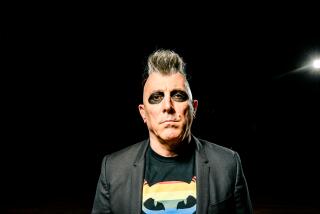A sad ‘Smile’
In the days after his death, Michael Jackson’s mother reportedly worried that if her son’s funeral was too long delayed, his soul might wander the earth. In a more secular sense, that is exactly what has been happening. Remembering Jackson -- debating his legacy, listening to his music, trying to make sense of his life -- has become the world’s favorite activity. The shape of Jackson’s shadow grows only more complicated as these thoughts and memories accrue.
Tuesday’s public memorial at Staples Center could have performed the function such events often do, channeling all the different stories into one narrative, helping make the emotions that Jackson’s death has generated feel neater and easier to digest.
Instead, the service (or was it a concert? Or a political event?) operated on several levels at once. Yet its two hours of music and eulogies made for many poignant and even wrenching moments, its incongruities adding up to the only reasonable response to an artistic giant whose meanings were always multiple and often contradictory.
Focus for a minute on just one musical offering: the rendition of “Smile” by Michael Jackson’s eldest brother, Jermaine. Following a bravely personal remembrance by Brooke Shields, Michael’s friend and fellow former child star, Jermaine took the stage wearing one silver glove and a red rose to sing this simple tune, which was cowritten by Charlie Chaplin and served as the theme for his much-beloved film “Modern Times.”
Where to start in interpreting what happened in the four or so minutes while Jermaine Jackson sang?
There was the personal pathos of the older brother, whose own youthful success was so dramatically eclipsed by his sibling’s, and who in recent days has told the media that he wishes he had died instead of Michael, singing in a voice eerily reminiscent of the one now lost. Jermaine nearly broke down near the end, right after the line, “What’s the use in crying”; the fans’ applause lifted him back up.
Then there was the song itself, a gentle admonition to cancel negative emotions behind a careful mask -- a particularly loaded message in light of the history of African American music, with its roots in the tangled history of blackface minstrelsy. Michael Jackson was hardly the first black pop star to deploy an often unreadable smile: one thinks of Louis Armstrong, and of that earlier crossover star, Nat King Cole, who similarly broke down barriers but was sometimes criticized for being too assimilationist.
Jermaine Jackson held his arms outstretched for much of the song, his gesture mirroring an image of Michael on the screens above him. It seemed like he was bearing a burden as well as celebrating a triumph. None of the memorial’s other musical performances were as rich in subtext as this one, but each was its own kind of maze that the singers had to negotiate.
Mariah Carey and her frequent duet partner, Trey Lorenz, were the first to try, giving a gentle spin to “I’ll Be There,” which was a hit for her as well as for the Jackson 5. Lorenz nearly toppled the song by coming on too strong, but Carey steered it back toward a tender reading, perfect for raising the much longed-for spirit of the young Michael, full of promise and innocence.
Gospel reminder
Backed by the Andrae Crouch Singers -- another resonant choice to perform, since Crouch is one of gospel’s most famous “crossover” modernizers -- Lionel Richie sang “Jesus Is Love” with his finger pointed skyward and as much grit as he could muster in his voice. This was one of many times that the memorial went back to church, reminding the fans in attendance that this was a service, not simply a concert.
The gospel elements also reinforced the connection between Jackson’s career and the civil rights movement made in speeches by several political leaders, including two of Martin Luther King Jr.’s children, Congresswoman Sheila Jackson-Lee and the Rev. Al Sharpton.
“He outsang the cynics, he outdanced his doubters, he outperformed the pessimists,” said Sharpton of Jackson, making a strong contribution to the fascinating process of Jackson’s posthumous rehabilitation as an African American hero.
One would have expected Jennifer Hudson’s role in the memorial to also serve this purpose.
After all, the mighty-voiced ingenue has been christened the New Aretha Franklin by many, a singer with enough gravity and guts to serve history’s needs.
Singing “Will You Be There,” Jackson’s most gospel-inspired song, in an angelic white dress, Hudson fulfilled that position. But again, it got complicated. Surrounded by the dancers who would have appeared onstage with Jackson during his comeback “This Is It” tour, she kept her composure while enduring some serious showbiz choreography. The image reminded those present that Jackson was a Hollywood child, as well as an inner-city baby -- and that Oscar winner and former “American Idol” contestant Hudson is also a product of those twin legacies.
The night’s other younger performers had to finesse their roles in reinterpreting Jackson’s meanings, and their own in relationship to him. John Mayer was tasteful performing an instrumental version of “Human Nature,” and though he didn’t seem as connected to the event as some of the participants, his presence made sense in light of Jackson’s well-known love of rock guitar.
Usher, a direct inheritor of Jackson’s style, made the risky decision to croon the melancholy “Gone Too Soon” while nearly touching Jackson’s golden coffin, but this assertion of closeness seemed justified when he choked up late in the song and was almost immediately enveloped in hugs by the Jackson family.
Twelve-year-old Shaheen Jafargholi was also in a tricky spot. The “Britain’s Got Talent” finalist wailed his way through the Jackson 5 song “Who’s Loving You,” right after the song’s writer, Smokey Robinson, had spoken about his astonishment at the child Michael Jackson’s skill with such “adult” compositions.
Jafargholi had spunk but not a lot of nuance. (He shouldn’t have to worry too much about the media anointing him the next Michael.) Kenny Ortega, the director of Jackson’s ill-fated comeback, explained after the boy sang that Jackson had been a fan, and that’s why he was there.
Really, though, what made more sense than featuring a child performer? As much as we are now mulling the intricacies of Jackson’s relationship to race and to the history of entertainment, we must also consider his status as an avatar of childhood.
The memorial’s final number, a group sing of “We Are the World” and “Heal the World” that included, among many performers, both the Andrae & Sandra Crouch Youth Choir and Jackson’s own three children, placed Jackson’s belief in the symbolic power of the child front and center.
As much as viewers were touched by the impromptu speech from Jackson’s daughter, Paris, at the memorial’s end -- her declaration that “Daddy has been the best father you can ever imagine” was heart-crushingly direct and true -- it’s worth remembering that the child was a primary subject of Jackson’s art too, and that we have only begun to absorb the complexities of that matter.
Wonder shines
Memorials often raise such knotty issues. Even ordinary souls, and certainly not ones as huge as Michael Jackson’s, cannot be contained within one set of remembrances. Yet simpler moments can also be profound, and this event had at least one.
Playing piano and singing a medley of two songs that seemed to speak directly about Jackson’s sudden death -- “Never Dreamed You’d Leave in Summer” and “They Won’t Go When I Go,” a song about finding relief in heaven -- Stevie Wonder found the musical route into unadorned mourning. The Staples Center crowd stayed quiet, taking it in.
Like Shields’ tear-inducing talk, Wonder’s performance wasn’t addressed to an icon, or a set of half-formed meanings. It was a message to a man, from a friend. And in that moment, the man’s loss was felt.
--
More to Read
The biggest entertainment stories
Get our big stories about Hollywood, film, television, music, arts, culture and more right in your inbox as soon as they publish.
You may occasionally receive promotional content from the Los Angeles Times.






